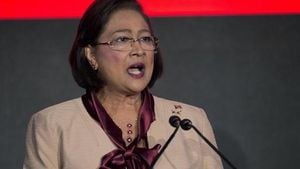Argentina has recently observed its monthly inflation rate decline to 2.4% for November, marking the lowest figure seen in more than four years. The release from the National Institute of Statistics and Census (INDEC) shows not only the numbers but signs of hope among the populace dealing with turbulence from economic reforms under President Javier Milei.
After years of grappling with extreme inflation, which peaked dramatically, the latest figures reflect a significant shift. Earlier this year, inflation soared to approximately 25.5% following the devaluation of the Argentine peso, which saw its value plummet by over 50%. Since then, the inflation rates have exhibited a notable downward trend, with November's figure dropping below the 3% threshold for the first time since November 2021, and annual inflation falling from 193% to 166%. Many analysts and citizens are left wondering if the worst phase of this financial crisis is finally behind them.
The Milei administration celebrated this decline as part of their aggressive austerity measures aimed at stabilizing the economy. Following these measures, it has been reported by the Economy Ministry, "Since the beginning of the administration, the country has gone through a stabilization process, leaving behind the scourge of inflation and ending with the ‘tax’ which affects Argentines the most.”
Several sectors within the country saw varying levels of price changes. Notably, education saw the highest monthly increase by 5.1%, followed by housing and utilities, which recorded rises of 4.5% due to hikes in rents and utilities bills. The cost of food and non-alcoholic beverages also surged by 4%. It is noteworthy to mention, though, six items have soared way above the inflation averages over the last year, with housing and utilities leading at 276.4%.
The Mills presidency has adopted strict economic policies, known popularly as the “chainsaw plan,” where aggressive cuts and changes were made to tackle inflation head-on. These have included cuts to various government subsidies, which critics argue have led to increased poverty levels—affecting over five million Argentines. For the average Argentine citizen, it means living through tough times, but many have expressed cautious optimism about potential recovery.
During his recent televised statements, Milei promised: "We are getting closer every day to inflation becoming little more than a bad memory," rallying support from those who hope for economic recovery and stability.
Contrasting sentiments arise when engaging with local merchants. Aram Boyaciyan, who runs a textile business, believes the recovery of purchasing power among middle-class citizens signifies turning points toward economic health. He remarked, "It seems to me the economy hit bottom two months ago," hinting at optimism based on observed sales improvements.
Despite the cheering from those within the Milei camp, there remains caution and clear-eyed analysis necessary as the country braces itself for what lies ahead. Given the global economic environment and prevalent uncertainties, both international investors and local consumers are keeping their eyes peeled for how Milei’s policies will continue to evolve.
The economic rollercoaster has not only positioned the government on the offensive against inflation but also set the stage for 2025 when discussions might steer toward less taxation, floating exchange rates, and even dollar transactions becoming norm across many sectors.
Despite some analysts predicting inflation may hover around 2.9% next month, there are rumors of optimism within the administration and local businesses about perhaps entering finally calmer waters without skyrocketing prices plaguing trades and everyday life.
Javier Milei’s administration is undoubtedly on the radar due to the substantial progress on one hand, yet it faces the stark reality of hardship brought about by austerity measures on the other. Balancing these realities might prove to be one of the monumental challenges of Milei’s term as the populace leans toward hope for recovery and stabilizing living conditions.
To conclude, Argentina's recent statistics not only paint the picture of economic deflation but also grab attention toward the pressing need for sustainable solutions as citizens yearn for more than just numbers—a desired life of stability amid the economic upheaval of the past few years.



